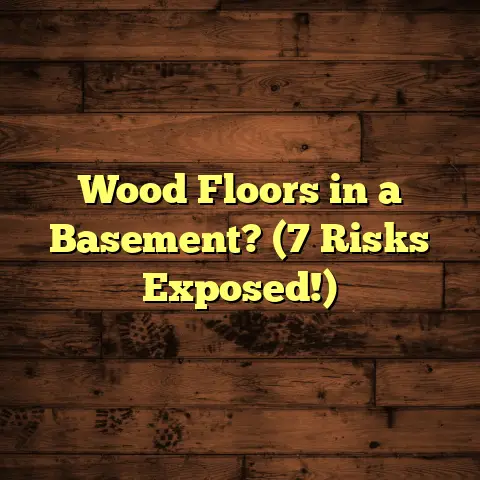Building Codes: What You MUST Know! (1 Mistake!)
(1 Mistake!)
I’m here to talk about something that might not be the most glamorous part of construction, but it’s absolutely crucial: building codes.
Think of building codes as the unsung heroes of your home or business. They’re the silent guardians ensuring your property is safe, efficient, and built to last.
Ignore them at your peril!
I’ve seen firsthand how a solid understanding of these codes can save you headaches, money, and even lives.
And trust me, I’ve also seen the chaos that unfolds when they’re ignored.
Did you know that a study by the National Institute of Standards and Technology (NIST) found that improved building codes could save billions of dollars annually in avoided disaster losses?
That’s a statistic that should grab your attention!
So, let’s dive in and unlock the secrets of building codes, and I’ll point out the one massive mistake you absolutely need to avoid.
Section 1: Understanding Building Codes
1. Definition of Building Codes
What exactly are building codes?
Simply put, they’re a set of rules and regulations that govern the design, construction, alteration, and maintenance of buildings.
Their primary goal?
To protect public health, safety, and welfare.
They cover everything from the structural integrity of your foundation to the fire resistance of your walls, and even the energy efficiency of your windows.
Think of them as a detailed instruction manual for building, ensuring everyone is on the same page and adhering to a minimum standard of quality.
2. History of Building Codes
Building codes weren’t always around.
In the early days, construction was often a wild west affair, with little regard for safety or quality.
Major disasters, like the Great Chicago Fire of 1871, highlighted the urgent need for standardized building practices.
This led to the development of early building codes, which primarily focused on fire safety.
Over time, these codes have evolved to address a wider range of concerns, including structural integrity, accessibility, energy conservation, and environmental protection.
Today, we have sophisticated, comprehensive codes that are constantly updated to reflect the latest advancements in building technology and safety standards.
3. Types of Building Codes
There’s a whole alphabet soup of building codes out there, and it can be confusing to navigate.
Here’s a breakdown of some of the most common types:
-
Residential Codes: These govern the construction and renovation of single-family homes, townhouses, and small apartment buildings.
-
Commercial Codes: These apply to larger buildings, such as office buildings, retail stores, and factories.
-
Electrical Codes: These cover the safe installation and maintenance of electrical systems, preventing fires and electrical shocks. The National Electrical Code (NEC) is the standard in the US.
-
Plumbing Codes: These regulate the installation of plumbing systems, ensuring safe and sanitary water supply and waste disposal.
-
Mechanical Codes: These cover heating, ventilation, and air conditioning (HVAC) systems, ensuring proper ventilation and energy efficiency.
-
Energy Codes: These focus on energy conservation, setting standards for insulation, windows, and HVAC systems to reduce energy consumption.
4. The Importance of Compliance
Why bother with all these codes?
Well, for starters, it’s the law!
Building without proper permits and inspections can lead to hefty fines, stop-work orders, and even the demolition of your unapproved work.
But more importantly, compliance with building codes is about safety.
These codes are designed to protect you, your family, and your community from potential hazards.
Think about it: a properly constructed foundation prevents structural collapse, fire-resistant materials can save lives in a fire, and accessible design ensures everyone can safely use a building.
Beyond safety, compliance can also save you money in the long run.
Energy-efficient buildings have lower utility bills, and durable construction reduces the need for costly repairs.
Section 2: Key Components of Building Codes
1. Safety Standards
Safety is at the heart of building codes.
Here are some key safety standards they enforce:
-
Structural Integrity: Codes specify minimum requirements for foundations, walls, roofs, and other structural elements to ensure they can withstand loads from wind, snow, and earthquakes.
-
Fire Safety: Codes mandate the use of fire-resistant materials, fire-rated doors and walls, smoke detectors, and fire suppression systems to prevent the spread of fire and ensure safe evacuation.
-
Accessibility: Codes require buildings to be accessible to people with disabilities, including ramps, elevators, accessible restrooms, and Braille signage.
2. Zoning Regulations
Zoning regulations are like the urban planning cousins of building codes.
They dictate how land can be used and developed in different areas of a city or town.
Zoning laws can specify things like:
-
Land Use: Whether a property can be used for residential, commercial, or industrial purposes.
-
Building Height and Setbacks: How tall a building can be and how far it must be set back from property lines.
-
Density: The number of dwelling units allowed per acre.
Zoning regulations and building codes work together to ensure that development is orderly, compatible with its surroundings, and meets the needs of the community.
3. Permitting Process
The permitting process is your official green light to start construction.
It typically involves these steps:
-
Application: You submit a detailed application to your local building department, including architectural plans, site plans, and other required documents.
-
Review: Building officials review your application to ensure it complies with all applicable building codes and zoning regulations.
-
Approval: If your application is approved, you receive a building permit, which authorizes you to begin construction.
Don’t even think about skipping this process.
Building without a permit can lead to serious consequences, including fines, stop-work orders, and even legal action.
4. Inspections
Inspections are like quality control checkpoints throughout the construction process.
Building inspectors visit the site at various stages to ensure that the work is being done in accordance with the approved plans and building codes.
Common inspections include:
-
Foundation Inspection: To verify that the foundation is properly constructed and meets structural requirements.
-
Framing Inspection: To ensure that the framing is structurally sound and meets code requirements for fire safety and energy efficiency.
-
Electrical Inspection: To verify that the electrical wiring is installed safely and meets code requirements.
-
Plumbing Inspection: To ensure that the plumbing system is properly installed and meets code requirements for water supply and waste disposal.
-
Final Inspection: To ensure that all work is complete and complies with all applicable codes before a certificate of occupancy is issued.
Inspectors are looking for potential problems like:
-
Code Violations: Work that doesn’t meet the requirements of the building code.
-
Safety Hazards: Conditions that could pose a risk to occupants, such as exposed wiring or structural defects.
-
Workmanship Issues: Poor quality workmanship that could compromise the durability or safety of the building.
Section 3: The 1 Mistake You MUST Avoid
1. Introduction to the Mistake
Alright, let’s get to the heart of the matter.
What’s the one mistake that I see builders and homeowners make all the time when it comes to building codes?
Assuming that building codes are the same everywhere!
I cannot stress this enough: building codes vary significantly from one jurisdiction to another.
What’s perfectly acceptable in one city might be a major violation in another.
2. Consequences of the Mistake
The consequences of this mistake can be severe.
Imagine building a deck according to the codes you used in your previous town, only to find out that your new town has stricter requirements for deck footings.
You could be forced to tear down the entire deck and rebuild it to meet the local codes.
This can lead to:
-
Safety Hazards: Building to outdated or incorrect codes can compromise the safety of your building and its occupants.
-
Legal Issues: Violations of building codes can result in fines, stop-work orders, and even legal action.
-
Financial Penalties: Correcting code violations can be expensive, especially if it involves tearing down and rebuilding work.
3. Real-life Case Studies
I once worked on a project where a contractor assumed that the electrical codes were the same as in the neighboring county.
He installed wiring that was not up to code for the specific area.
The inspector red-tagged the entire project, and the contractor had to rip out all the wiring and reinstall it, costing him thousands of dollars and delaying the project by weeks.
Another time, a homeowner built an addition to his house without checking the local zoning regulations.
He built too close to the property line and was forced to tear down part of the addition to comply with the setback requirements.
These are just a couple of examples of how failing to check local building codes can lead to major problems.
Section 4: How to Stay Informed about Building Codes
1. Resources for Homeowners and Builders
So, how do you avoid making this critical mistake?
Here are some resources to help you stay informed about building codes:
-
Local Building Departments: Your local building department is your primary source of information about building codes and permitting requirements. They can provide you with copies of the codes, answer your questions, and guide you through the permitting process.
-
Online Databases: Many jurisdictions have online databases where you can access building codes and regulations. The International Code Council (ICC) website is a great resource.
-
Professional Organizations: Organizations like the National Association of Home Builders (NAHB) and the American Institute of Architects (AIA) offer resources and training on building codes and best practices.
2. Continuing Education
For contractors and builders, continuing education is essential.
Building codes are constantly evolving, and it’s important to stay up-to-date on the latest changes.
Many professional organizations and community colleges offer courses and seminars on building codes.
3. Networking with Professionals
Networking with architects, engineers, and code officials can also be a valuable way to stay informed.
These professionals can provide you with insights and advice on building code compliance.
Attend industry events, join professional organizations, and build relationships with people who have expertise in building codes.
Section 5: Future Trends in Building Codes
1. Sustainability and Environmental Codes
Building codes are increasingly focused on sustainability and environmental impact.
Expect to see more stringent requirements for:
-
Energy Efficiency: Higher insulation levels, more efficient windows and HVAC systems, and requirements for renewable energy sources.
-
Water Conservation: Requirements for low-flow fixtures, rainwater harvesting systems, and greywater reuse.
-
Green Building Materials: Incentives for using recycled, renewable, and locally sourced materials.
2. Technological Advances
Technology is also influencing building codes.
Smart buildings with automated systems for lighting, heating, and security are becoming more common.
Building codes are being updated to address the unique challenges and opportunities presented by these technologies.
3. Changes Due to Climate Considerations
Climate change is prompting updates to building codes related to resilience and natural disaster preparedness.
Expect to see more stringent requirements for:
-
Flood Resistance: Building codes in coastal areas are being updated to require buildings to be elevated above flood levels.
-
Wind Resistance: Building codes in hurricane-prone areas are being updated to require buildings to withstand higher wind speeds.
-
Wildfire Resistance: Building codes in wildfire-prone areas are being updated to require the use of fire-resistant materials and vegetation management.
Conclusion: The Importance of Knowledge in Building Codes
So, there you have it!
A comprehensive overview of building codes and the one mistake you absolutely must avoid.
Remember, understanding building codes is not just about legal compliance.
It’s about creating safe, durable, and valuable structures for the future.
Take the time to educate yourself, stay informed about local codes, and don’t be afraid to ask questions.
Your efforts will pay off in the long run!
Happy building!




